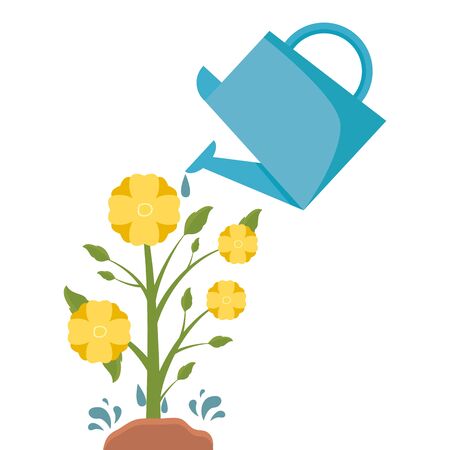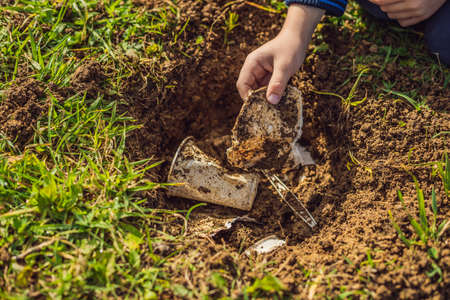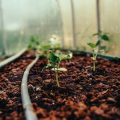1. Understanding the Basics of Healthy Soil
Before you can fix soil problems in your garden, its important to understand what healthy soil looks like and why it matters. Good soil is the foundation of a productive garden—it supports strong plant roots, holds moisture, supplies nutrients, and allows for proper air flow. Let’s break down the key components that make soil healthy.
Soil Structure
Soil structure refers to how soil particles (sand, silt, and clay) bind together into clumps or aggregates. A well-structured soil has plenty of pore spaces between these clumps, allowing water and air to move freely. This encourages root growth and helps beneficial organisms thrive.
Common Soil Textures
| Soil Type | Description | Drainage | Ideal Use |
|---|---|---|---|
| Sandy | Loose, gritty feel; drains quickly | Fast | Root vegetables like carrots and potatoes |
| Clay | Sticky when wet; compacts easily | Slow | Moisture-loving plants like asters and daylilies |
| Loam | Balanced mix of sand, silt, and clay | Moderate | Most vegetables and flowers |
Nutrient Content
Your garden soil needs essential nutrients to support plant health. The three primary nutrients are nitrogen (N), phosphorus (P), and potassium (K). These are often referred to as N-P-K on fertilizer labels. Secondary nutrients like calcium, magnesium, and sulfur also play a role in plant development.
Nutrient Functions Overview
| Nutrient | Function in Plants |
|---|---|
| Nitrogen (N) | Promotes leafy growth and green color |
| Phosphorus (P) | Aids in root development and flowering |
| Potassium (K) | Supports overall plant health and disease resistance |
Soil pH Level
The pH level of your soil affects how easily plants can absorb nutrients. Most garden plants prefer a slightly acidic to neutral pH range of 6.0 to 7.0. If your pH is too high or too low, plants may struggle even if nutrients are present in the soil.
Soil pH Guide
| pH Level | Status | Effect on Plants |
|---|---|---|
| <5.5 | Strongly Acidic | Nutrient deficiencies common; poor growth |
| 6.0–7.0 | Iideal Range for Most Plants | Nutrients are readily available; healthy growth |
| >7.5 | Alkaline | Certain nutrients become less available; stunted plants possible |
Moisture Retention and Drainage Balance
A healthy garden soil holds enough moisture for plant roots without becoming soggy or waterlogged. Too much water can suffocate roots and lead to rot, while too little dries out plants quickly. Adding organic matter like compost improves both water retention in sandy soils and drainage in clay soils.
Quick Tip:
If youre unsure about your soils moisture level, do a simple squeeze test. Grab a handful of damp soil—if it crumbles easily after squeezing, its just right. If it stays compacted or drips water, it may need better drainage.
Understanding these basic qualities of healthy soil gives you the tools to recognize issues early—and take steps to fix them before they affect your gardens productivity.
2. Identifying Common Soil Problems
Healthy soil is the foundation of a thriving garden, but when things go wrong, your plants will let you know. Recognizing the signs early can help you take action before your garden suffers serious damage. Here’s how to spot common soil problems just by paying attention to what’s happening in your yard.
Signs Your Soil Might Be in Trouble
If your plants arent growing like they should, the issue might be below the surface. Look out for these telltale signs:
| Problem Sign | What It Means |
|---|---|
| Compacted Soil | The soil feels hard and dense; roots struggle to grow, and water doesnt soak in easily. |
| Water Runoff | Water pools or runs off instead of soaking in—usually a sign of poor drainage or compacted soil. |
| Yellowing Leaves | This could mean nutrient deficiency, poor drainage, or root stress due to bad soil structure. |
| Stunted Growth | Your plants aren’t growing as expected—often linked to low fertility, pH imbalance, or lack of organic matter. |
How to Check Your Soils Health
You don’t need fancy tools to start evaluating your soil. Here are a few simple ways to get a better idea of what’s going on underground:
Squeeze Test
Scoop up some moist (not wet) soil and squeeze it in your hand. If it forms a tight ball and doesn’t crumble when poked, it may be too compacted or have too much clay. If it falls apart too easily, it might be too sandy.
Puddle Test
After watering or a rainstorm, check how long water stays pooled on the surface. If it lingers for more than a few hours, your soil may have drainage issues.
Root Inspection
Carefully dig around a plant and look at its roots. Healthy roots should be white and spread evenly through the soil. If they’re brown, mushy, or circling tightly, your soil may be causing stress.
The Importance of Texture and Structure
The texture of your soil—whether its sandy, loamy, or clay-heavy—affects how well it holds water and nutrients. Loam is ideal for most gardens because it holds moisture without becoming waterlogged and allows air to reach plant roots. When soil structure breaks down due to compaction or erosion, it becomes harder for plants to thrive.
A Visual Guide to Watch For
- Dull or pale leaves: May indicate nitrogen deficiency.
- Brittle stems: Could signal poor potassium levels.
- Moss growth: Usually points to poor drainage or acidic soil conditions.
If you notice any combination of these symptoms in your garden, its likely time to take a closer look at what’s happening beneath the surface. Understanding these early warning signs can help you stay one step ahead of potential problems.

3. Testing Your Soil
Before you can fix any soil problems in your garden, you need to know whats actually going on beneath the surface. Testing your soil is a simple but important step that helps you understand its pH level, nutrient content, and overall composition. You can either test it yourself at home or send a sample to your local cooperative extension office for more detailed results.
At-Home Soil Testing Kits
You can find easy-to-use soil testing kits at most garden centers or online. These kits usually test for pH, nitrogen (N), phosphorus (P), and potassium (K)—the key nutrients plants need to grow. Follow the instructions on the kit carefully, and make sure you collect samples from different areas of your garden for the most accurate results.
What Do the Results Mean?
| Test | Ideal Range | What It Means |
|---|---|---|
| pH Level | 6.0 – 7.0 | This range is ideal for most vegetables and flowers. A low pH means your soil is acidic; a high pH means it’s alkaline. |
| Nitrogen (N) | Medium | Nitrogen supports leafy growth. Too little leads to yellow leaves; too much can cause excessive foliage with few fruits. |
| Phosphorus (P) | Medium | Helps with root development and flowering. Low phosphorus can mean poor blooms or weak roots. |
| Potassium (K) | Medium | Aids in disease resistance and overall plant health. Low levels may result in weak stems and poor fruit quality. |
Sending Samples to a Local Extension Office
If youre looking for a more thorough analysis, consider sending a sample to your local cooperative extension service. These services are often run through universities and provide detailed reports on nutrient levels, organic matter, soil texture, and even recommendations specific to your regions climate and common crops.
How to Collect a Soil Sample
- Use a clean trowel or shovel to dig 6–8 inches deep in several spots around your garden.
- Mix the soil together in a clean bucket to get an average sample.
- Scoop about one cup of this mixed soil into the container provided by the extension office or recommended by their website.
No matter which method you choose, testing your soil gives you a clear picture of what’s happening underground so you can give your plants exactly what they need to thrive.
4. Fixing Nutrient Deficiencies and Imbalances
Healthy soil is the foundation of a thriving garden, but sometimes your plants may struggle due to missing or imbalanced nutrients. Learning how to spot these issues and fix them with compost, fertilizers, and organic matter can make a big difference in your garden’s success.
Identifying Common Nutrient Deficiencies
Each essential nutrient plays a specific role in plant health. When one is lacking, your plants will show clear signs. Here are some common symptoms and what they usually mean:
| Nutrient | Deficiency Signs | Common Fixes |
|---|---|---|
| Nitrogen (N) | Yellowing leaves, especially older ones; stunted growth | Add composted manure, blood meal, or fish emulsion |
| Phosphorus (P) | Purple or dark green leaves; poor root growth | Apply bone meal or rock phosphate |
| Potassium (K) | Leaf edges turning brown or scorched; weak stems | Use wood ash or kelp meal |
| Calcium (Ca) | Blossom end rot in tomatoes; distorted new leaves | Add gypsum or crushed eggshells |
| Magnesium (Mg) | Yellowing between leaf veins on older leaves | Add Epsom salt (magnesium sulfate) |
Balancing Soil pH Levels
If your soil is too acidic or too alkaline, plants can’t absorb nutrients properly—even if those nutrients are present. A soil test kit can help you figure out your soil’s pH.
How to Adjust Soil pH:
| Soil Condition | Symptoms | Solutions |
|---|---|---|
| Too Acidic (pH below 6.0) | Poor growth; yellow leaves; nutrient lockout | Add garden lime or wood ash to raise pH |
| Too Alkaline (pH above 7.5) | Pale leaves; slow growth; iron deficiency symptoms | Add sulfur or peat moss to lower pH |
Using Compost and Organic Matter for Long-Term Health
Compost not only adds nutrients but also improves soil texture and microbial life. Mix it into the top few inches of soil at least once a year. Other great organic amendments include:
- Aged manure: Rich in nitrogen and boosts overall fertility.
- Coconut coir or peat moss: Helps retain moisture and improve structure.
- Leaf mold: Breaks down slowly, adding both nutrients and organic content.
Pro Tip:
If youre unsure which nutrients your soil needs, start with a basic soil test from your local extension service—they often provide region-specific advice tailored to your area.
Taking the time to understand and address nutrient deficiencies will lead to stronger plants, better harvests, and a more vibrant garden season after season.
5. Improving Drainage and Soil Structure
Good soil structure and proper drainage are essential for a healthy garden. Poor drainage can lead to waterlogged roots, while compacted soil prevents air and nutrients from reaching plant roots. Luckily, there are simple and effective ways to improve these conditions right in your backyard.
Use Raised Beds
One of the easiest solutions for poor drainage is building raised beds. Raised beds help control soil quality, improve water runoff, and prevent compaction caused by foot traffic. Theyre especially helpful in areas with heavy clay soils or frequent rain.
Plant Cover Crops
Cover crops like clover, rye, or buckwheat can greatly improve soil structure. They break up compacted soil with their root systems, add organic matter when tilled under, and prevent erosion during off-seasons.
| Cover Crop | Main Benefits | Best Time to Plant |
|---|---|---|
| Clover | Adds nitrogen, reduces erosion | Late summer to early fall |
| Rye | Breaks up compacted soil, suppresses weeds | Fall |
| Buckwheat | Improves organic matter, attracts pollinators | Spring or summer |
Till the Right Way
Tilling can help loosen compacted soil but over-tilling can make things worse. Till only when necessary and avoid doing it when the soil is too wet. Wet soil compacts easily under pressure, which defeats the purpose of tilling in the first place.
Tilling Tips:
- Till in early spring or fall when the soil is moist but not soggy.
- Avoid walking on freshly tilled areas to prevent re-compaction.
- Add compost before tilling to mix organic material into the soil.
Add Organic Matter Regularly
Mixing compost, aged manure, or shredded leaves into your garden beds improves both drainage and aeration over time. These materials help bind sandy soils and loosen heavy clay soils.
Create Air Channels Naturally
You can also improve aeration by planting deep-rooted vegetables like carrots or daikon radishes. As they grow and decompose, they leave behind channels that allow air and water to move more freely through the soil.
Deep-Rooted Plants That Help Soil Aeration:
- Carrots
- Daikon radish
- Sunchokes (Jerusalem artichokes)
- Sorghum-sudangrass (as a cover crop)
Taking these steps will not only improve your soil’s ability to drain properly but also create an environment where your plants can thrive season after season.
6. Maintaining Long-Term Soil Health
Keeping your garden soil healthy for the long haul is key to growing strong plants and getting good harvests year after year. Even if you’ve fixed immediate problems, it’s important to build good habits that protect and improve your soil over time. Here are some simple ways to do just that.
Crop Rotation
Planting the same crops in the same spot each year can lead to nutrient depletion and increase the risk of pests and diseases. Crop rotation helps prevent this by giving soil a chance to recover and by breaking pest cycles. Try rotating plant families every season. For example:
| Year | Bed A | Bed B | Bed C |
|---|---|---|---|
| 1 | Tomatoes (Nightshades) | Carrots (Root Crops) | Lettuce (Leafy Greens) |
| 2 | Lettuce (Leafy Greens) | Tomatoes (Nightshades) | Carrots (Root Crops) |
| 3 | Carrots (Root Crops) | Lettuce (Leafy Greens) | Tomatoes (Nightshades) |
Mulching
Mulch acts like a protective blanket for your soil. It keeps moisture in, blocks weeds, and adds organic matter as it breaks down. Use materials like shredded leaves, straw, or bark mulch around plants, especially during hot summers or cold winters.
Adding Organic Matter Regularly
Your soil needs food too! Adding compost, aged manure, or leaf mold feeds the soil microbes that help your plants grow. Try adding a couple of inches of compost to your beds each spring or fall. This improves soil texture and boosts nutrients naturally.
Easy Sources of Organic Matter
- Compost from kitchen scraps and yard waste
- Aged animal manure (like from cows, chickens, or horses)
- Cover crops like clover or rye that can be tilled into the soil
Minimizing Chemical Use
Pesticides and synthetic fertilizers might give quick results, but they can harm beneficial insects, pollute groundwater, and weaken long-term soil health. Instead, focus on natural solutions:
- Use compost tea or fish emulsion instead of chemical fertilizers
- Attract beneficial insects like ladybugs with native flowers
- Solve pest issues early with hand-picking or organic sprays when needed
Taking care of your soil isn’t just a one-time fix—it’s an ongoing process that pays off season after season. With a few consistent practices like rotating crops, mulching, feeding your soil, and going easy on chemicals, your garden will stay healthy and productive for years to come.

